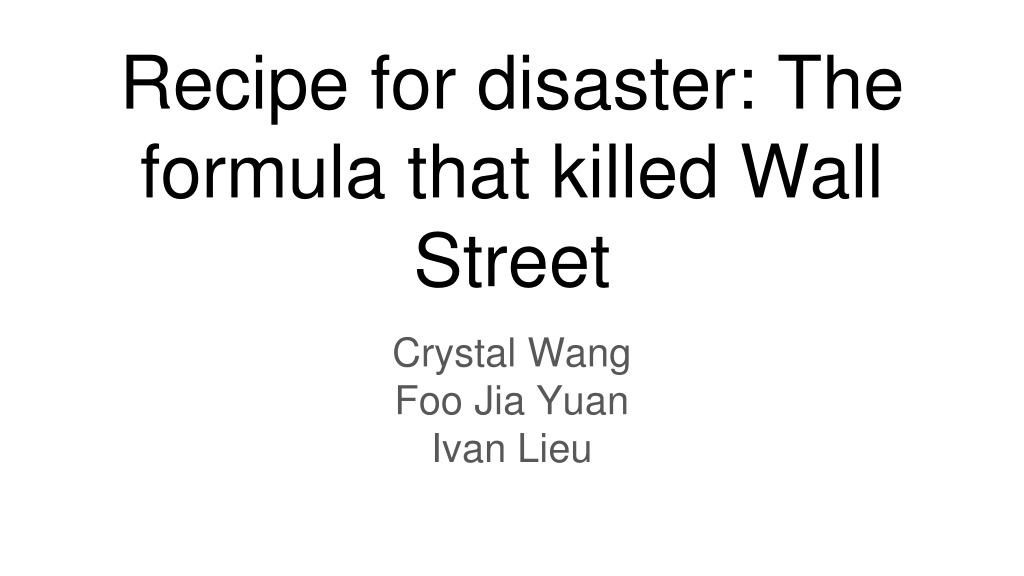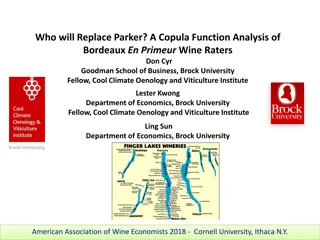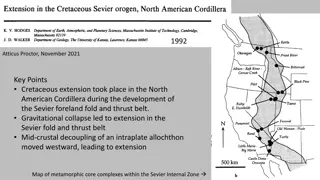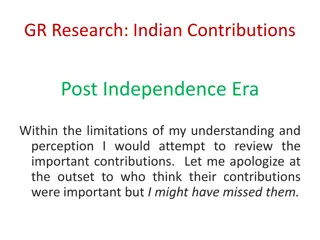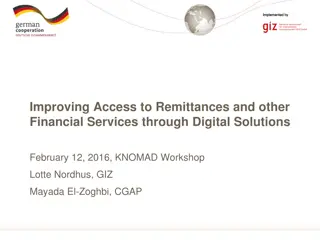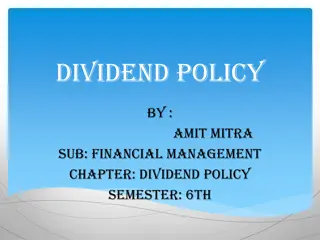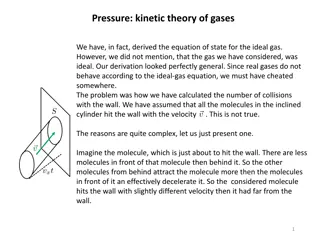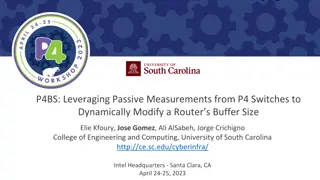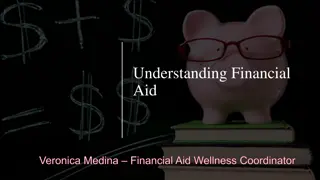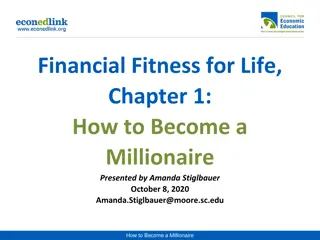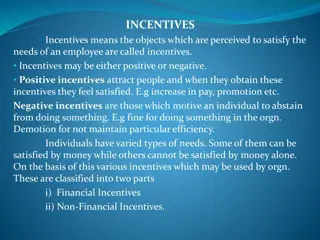Unraveling the Gaussian Copula Model and the Financial Collapse of 2008
Explore the dangers of relying on the Gaussian copula model for pricing risks in the financial world, leading to the catastrophic collapse of 2008. Discover how the lure of profits overshadowed warnings about the model's limitations, causing trillions of dollars in losses and threatening the global banking system. Delve into the complexities of the bond market and the challenges faced by bond investors in assessing risk, especially when dealing with mortgage pools. Learn how tranching plays a role in creating safe investments from pooled assets.
Download Presentation

Please find below an Image/Link to download the presentation.
The content on the website is provided AS IS for your information and personal use only. It may not be sold, licensed, or shared on other websites without obtaining consent from the author. Download presentation by click this link. If you encounter any issues during the download, it is possible that the publisher has removed the file from their server.
E N D
Presentation Transcript
Recipe for disaster: The formula that killed Wall Street Crystal Wang Foo Jia Yuan Ivan Lieu
Questions to answer: One cause of the financial collapse of 2008 was the use of poor methodology for estimating the risk of so-called collateralized debt obligations (CDOs). This article explains in layman s terms the Gaussian copula model that was often used for this purpose. 1. Was it known beforehand that reliance on the Gaussian copula model to price risk was dangerous? 2. On what data does the copula model rely?
Gaussian Copula Model Invented by David X. Li Financial technology that allowed hugely complex risks to be modeled with more ease and accuracy Possible for traders to sell vast quantities of new securities, expanding financial markets to unimaginable levels This method was adopted by everybody (bond investors,Wall Street banks, ratings agencies and regulators) People were making a lot of money out of it that that warnings about its limitations were largely ignored
Gaussian Copula Model Problems appeared in the initial stage: Financial markets behaved in a way that the users of the formula didn t expect it to By 2008, the flaws of the system swallowed up trillions of dollars, putting the survival of global banking system in serious peril
How did it happen? Bond market - multitrillion-dollar system that allows pension funds, insurance companies, and hedge funds to lend trillions of dollars to companies, countries and home buyers Eg: When a company borrows money by issuing a bond, investors investigate if company has the capability to repay them. The higher the perceived risk, the higher the interest rate the bond must carry.
How did it happen? Bond investors also invest in pools of hundreds or even thousands of mortgages. The potential sums involved are surprising. For example, Americans now owe more than $11 trillion on their homes. But mortgage pools are messier than most bonds. There's no guaranteed interest rate There's certainly no fixed maturity date And most problematic, there's no easy way to assign a single probability to the chance of default.
Tranching Divides a pool and allows for the creation of safe bonds with a risk-free triple- A credit rating. Investors in the first tranche, or slice, are first in line to be paid off. Those next in line might get only a double-A credit rating on their tranche of bonds but will be able to charge a higher interest rate for bearing the slightly higher chance of default.
Tranching Investors believed there was no way hundreds of homeowners would all default on their loans at the same time. One person might lose his job, another might fall ill. But those are individual calamities that don't affect the mortgage pool much as a whole However, not all catastrophes are individual, it also involves correlation. Falling house prices, affect a large number of people at once. If i default on my mortgage (as a result of falling house prices), it is likely that my neighbours will default too - CORRELATION Investors like risk. What they hate is not knowing how big the risk is. Hence, bond investors and mortgage lenders desperately want to be able to measure, model, and price correlation.
Correlation Probability that Alice s parents will get divorced this year is about 5 percent The risk of her getting head lice is about 5 percent The chance of her seeing a teacher slip on a banana peel is about 5 percent The likelihood of her winning the class spelling bee is about 5 percent If Britney's parents get divorced, chances that Alice's parents will get divorced too is still about 5 percent: The correlation there is close to zero. If Britney gets head lice, the chance that Alice will get head lice is much higher, about 50 percent which means the correlation is probably up in the 0.5 range. If Britney sees a teacher slip on a banana peel, chances that Alice will see it too is very high. It could be as much as 95 percent, which means the correlation is close to 1.
Correlation in the world of mortgages In the world of mortgages, it's harder to assess the correlation. What is the chance that any given home will decline in value? And what is the chance that if a home in one state falls in value, a similar home in another state will fall in value as well?
Credit Default Swaps If you're an investor, either lend directly to borrowers or sell investors credit default swaps. Either way, you get a regular income stream and if the borrower defaults, you lose money. The returns on both strategies are nearly identical, but because an unlimited number of credit default swaps can be sold against each borrower, the supply of swaps isn't constrained by the way the supply of bonds is Hence the CDS market managed to grow extremely rapidly.
How does the Gaussian Copula Model work? The function was used to price hundreds of billions of dollars worth of CDOs filled with mortgages Used CDS prices to calculate correction Was a period where house prices soared -> default correlations will be low When mortgage boom ended abruptly, home values starts to fall -> correlations increased
How does the Gaussian Copula Model work? Bankers knew that the model was highly sensitive to house-price appreciation Nobody was willing to stop the creation of CDO, just build more and more on it When house prices stop rising, people knew they were in trouble as sensitivity to house prices was huge Very small changes in assumptions could result in very large changes in correlation number Observed results were much less volatile that it should be
How does the Gaussian Copula Model work? Nobody knew and nobody asked Quants were aware of the copula s weaknesses, but not the ones to make the big asset-allocation decisions Managers made the call, who lacked knowledge about what this function was exactly about Only understand something as simple as a single correlation number
How does the Gaussian Copula Model work? Relationship between 2 assets can never be captured by a single scalar quantity Example: Share prices of 2 shoe manufacturers Both companies do well, correlation high When one company gets many celebrity endorsements and starts to steal market share from the other, stock prices diverge and correlation becomes negative When everyone turns to wearing slippers, both companies lose profit and correlation turns positive again Impossible to sum up such a history in one correlation number, but the function assumes that correlation was more of a constant than a variable.
Damage was actually foreseeable.. Experts warned that correlations between financial quantities are highly unstable and no theory should be built on it However Li assumed that the correlation was a constant rather than something unstable Furthermore, people were making too much money from using the formula to stop In the CDO market, people used the model to convince themselves that there were no risks. But when it happens, it can be devastating
Who is to be blamed? Li cant be blamed because he only created the model Bankers were the ones who misinterpreted it The real danger is not because 1 or 2 people adopted it, but the entire market Everybody doing the same thing is the classic recipe for a bubble and inevitable burst
Conclusion Do not believe what you see on the surface Do some research before deciding whether or not it is reliable
